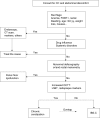Optimal management of constipation associated with irritable bowel syndrome
- PMID: 26028974
- PMCID: PMC4425337
- DOI: 10.2147/TCRM.S54298
Optimal management of constipation associated with irritable bowel syndrome
Abstract
Irritable bowel syndrome (IBS) is a common chronic functional disorder of the gastrointestinal tract, meanly characterized by recurrent abdominal pain or discomfort and altered bowel habit. It is a complex disorder involving biological, environmental, and psychosocial factors. The diagnosis is achieved according to the Rome III criteria provided that organic causes have been excluded. Although IBS does not constitute a life-threatening condition, it has a remarkable prevalence and profoundly reduces the quality of life with burdening socioeconomic costs. One of the principal concerns about IBS is the lack of effective therapeutic options. Up to 40% of patients are not satisfied with any available medications, especially those suffering from chronic constipation. A correct management of IBS with constipation should evolve through a global approach focused on the patient, starting with careful history taking in order to assess the presence of organic diseases that might trigger the disorder. Therefore, the second step is to examine lifestyle, dietary habits, and psychological status. On these bases, a step-up management of disease is recommended: from fiber and bulking agents, to osmotic laxative drugs, to new molecules like lubiprostone and linaclotide. Although new promising tools for relief of bowel-movement-related symptoms are being discovered, a dedicated doctor-patient relationship still seems to be the key for success.
Keywords: IBS; functional gastrointestinal disorders; laxatives.
Figures


References
-
- Chang L. Review article: epidemiology and quality of life in functional gastrointestinal disorders. Aliment Pharmacol Ther. 2004;20(Suppl 7):31–39. - PubMed
-
- Rome Foundation Guidelines – Rome III Diagnostic Criteria for Functional Gastrointestinal Disorders. J Gastrointestin Liver Dis. 2006;15:307–312. - PubMed
-
- American College of Gastroenterology Task Force on Irritable Bowel Syndrome. Brandt LJ, Chey WD, et al. An evidence-based position statement on the management of irritable bowel syndrome. Am J Gastroenterol. 2009;104(Suppl 1):S1–S35. - PubMed
-
- Hungin AP, Whorwell PJ, Tack J, Mearin F. The prevalence, patterns and impact of irritable bowel syndrome: an international survey of 40,000 subjects. Aliment Pharmacol Ther. 2003;17:643–650. - PubMed
-
- Chang JY, Talley NJ. An update on irritable bowel syndrome: from diagnosis to emerging therapies. Curr Opin Gastroenterol. 2011;27:72–78. - PubMed
Publication types
LinkOut - more resources
Full Text Sources

